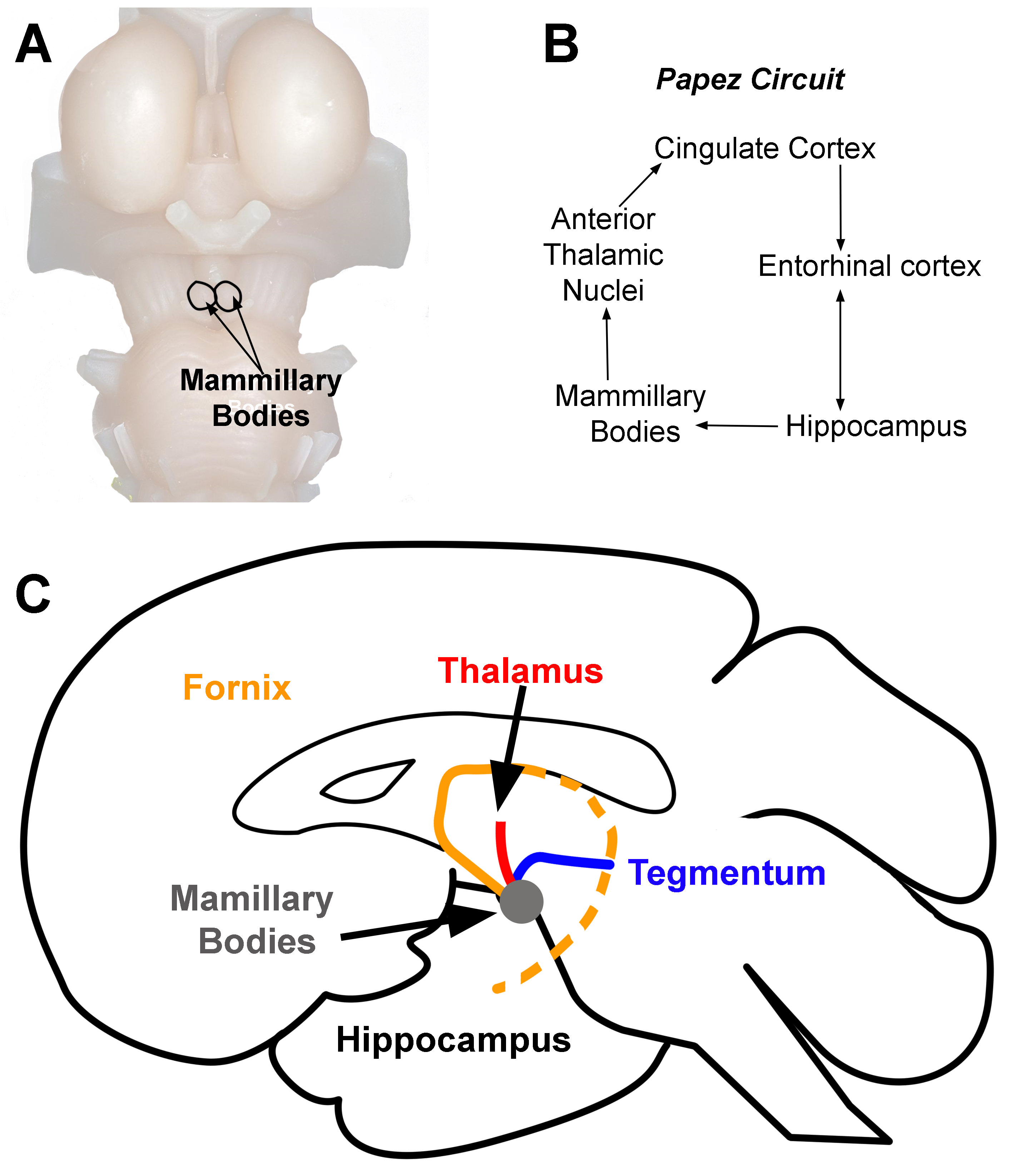[1]
Vann SD, Aggleton JP. The mammillary bodies: two memory systems in one? Nature reviews. Neuroscience. 2004 Jan:5(1):35-44
[PubMed PMID: 14708002]
[2]
Vertes RP, Albo Z, Viana Di Prisco G. Theta-rhythmically firing neurons in the anterior thalamus: implications for mnemonic functions of Papez's circuit. Neuroscience. 2001:104(3):619-25
[PubMed PMID: 11440795]
[3]
Aggleton JP, Brown MW. Episodic memory, amnesia, and the hippocampal-anterior thalamic axis. The Behavioral and brain sciences. 1999 Jun:22(3):425-44; discussion 444-89
[PubMed PMID: 11301518]
[4]
Thomas AG, Koumellis P, Dineen RA. The fornix in health and disease: an imaging review. Radiographics : a review publication of the Radiological Society of North America, Inc. 2011 Jul-Aug:31(4):1107-21. doi: 10.1148/rg.314105729. Epub
[PubMed PMID: 21768242]
[5]
Copenhaver BR, Rabin LA, Saykin AJ, Roth RM, Wishart HA, Flashman LA, Santulli RB, McHugh TL, Mamourian AC. The fornix and mammillary bodies in older adults with Alzheimer's disease, mild cognitive impairment, and cognitive complaints: a volumetric MRI study. Psychiatry research. 2006 Oct 30:147(2-3):93-103
[PubMed PMID: 16920336]
[6]
Cacciola A, Milardi D, Calamuneri A, Bonanno L, Marino S, Ciolli P, Russo M, Bruschetta D, Duca A, Trimarchi F, Quartarone A, Anastasi G. Constrained Spherical Deconvolution Tractography Reveals Cerebello-Mammillary Connections in Humans. Cerebellum (London, England). 2017 Apr:16(2):483-495. doi: 10.1007/s12311-016-0830-9. Epub
[PubMed PMID: 27774574]
[8]
Lammel S, Lim BK, Malenka RC. Reward and aversion in a heterogeneous midbrain dopamine system. Neuropharmacology. 2014 Jan:76 Pt B(0 0):351-9. doi: 10.1016/j.neuropharm.2013.03.019. Epub 2013 Apr 8
[PubMed PMID: 23578393]
[9]
Balak N, Balkuv E, Karadag A, Basaran R, Biceroglu H, Erkan B, Tanriover N. Mammillothalamic and Mammillotegmental Tracts as New Targets for Dementia and Epilepsy Treatment. World neurosurgery. 2018 Feb:110():133-144. doi: 10.1016/j.wneu.2017.10.168. Epub 2017 Nov 10
[PubMed PMID: 29129763]
[10]
Redila V,Kinzel C,Jo YS,Puryear CB,Mizumori SJ, A role for the lateral dorsal tegmentum in memory and decision neural circuitry. Neurobiology of learning and memory. 2015 Jan;
[PubMed PMID: 24910282]
[11]
Levisohn L, Cronin-Golomb A, Schmahmann JD. Neuropsychological consequences of cerebellar tumour resection in children: cerebellar cognitive affective syndrome in a paediatric population. Brain : a journal of neurology. 2000 May:123 ( Pt 5)():1041-50
[PubMed PMID: 10775548]
[12]
Qin C, Li J, Tang K. The Paraventricular Nucleus of the Hypothalamus: Development, Function, and Human Diseases. Endocrinology. 2018 Sep 1:159(9):3458-3472. doi: 10.1210/en.2018-00453. Epub
[PubMed PMID: 30052854]
Level 2 (mid-level) evidence
[13]
Kril JJ, Harper CG. Neuroanatomy and neuropathology associated with Korsakoff's syndrome. Neuropsychology review. 2012 Jun:22(2):72-80. doi: 10.1007/s11065-012-9195-0. Epub 2012 Apr 14
[PubMed PMID: 22528862]
[14]
Roberts DE,Killiany RJ,Rosene DL, Neuron numbers in the hypothalamus of the normal aging rhesus monkey: stability across the adult lifespan and between the sexes. The Journal of comparative neurology. 2012 Apr 15;
[PubMed PMID: 21935936]
Level 2 (mid-level) evidence
[15]
Pascual JM, Prieto R, Carrasco R, Barrios L. Displacement of mammillary bodies by craniopharyngiomas involving the third ventricle: surgical-MRI correlation and use in topographical diagnosis. Journal of neurosurgery. 2013 Aug:119(2):381-405. doi: 10.3171/2013.1.JNS111722. Epub 2013 Mar 29
[PubMed PMID: 23540270]
[16]
Dusoir H, Kapur N, Byrnes DP, McKinstry S, Hoare RD. The role of diencephalic pathology in human memory disorder. Evidence from a penetrating paranasal brain injury. Brain : a journal of neurology. 1990 Dec:113 ( Pt 6)():1695-706
[PubMed PMID: 2276041]
[17]
Hescham S, Jahanshahi A, Meriaux C, Lim LW, Blokland A, Temel Y. Behavioral effects of deep brain stimulation of different areas of the Papez circuit on memory- and anxiety-related functions. Behavioural brain research. 2015 Oct 1:292():353-60. doi: 10.1016/j.bbr.2015.06.032. Epub 2015 Jun 25
[PubMed PMID: 26119240]
[18]
Hescham S, Lim LW, Jahanshahi A, Blokland A, Temel Y. Deep brain stimulation in dementia-related disorders. Neuroscience and biobehavioral reviews. 2013 Dec:37(10 Pt 2):2666-75. doi: 10.1016/j.neubiorev.2013.09.002. Epub 2013 Sep 20
[PubMed PMID: 24060532]
[19]
Gratwicke J, Kahan J, Zrinzo L, Hariz M, Limousin P, Foltynie T, Jahanshahi M. The nucleus basalis of Meynert: a new target for deep brain stimulation in dementia? Neuroscience and biobehavioral reviews. 2013 Dec:37(10 Pt 2):2676-88. doi: 10.1016/j.neubiorev.2013.09.003. Epub 2013 Sep 11
[PubMed PMID: 24035740]
[20]
Stypulkowski PH, Stanslaski SR, Giftakis JE. Modulation of hippocampal activity with fornix Deep Brain Stimulation. Brain stimulation. 2017 Nov-Dec:10(6):1125-1132. doi: 10.1016/j.brs.2017.09.002. Epub 2017 Sep 6
[PubMed PMID: 28927833]
[21]
Zhang C, Hu WH, Wu DL, Zhang K, Zhang JG. Behavioral effects of deep brain stimulation of the anterior nucleus of thalamus, entorhinal cortex and fornix in a rat model of Alzheimer's disease. Chinese medical journal. 2015 May 5:128(9):1190-5. doi: 10.4103/0366-6999.156114. Epub
[PubMed PMID: 25947402]
[22]
Sankar T,Chakravarty MM,Bescos A,Lara M,Obuchi T,Laxton AW,McAndrews MP,Tang-Wai DF,Workman CI,Smith GS,Lozano AM, Deep Brain Stimulation Influences Brain Structure in Alzheimer's Disease. Brain stimulation. 2015 May-Jun;
[PubMed PMID: 25814404]

